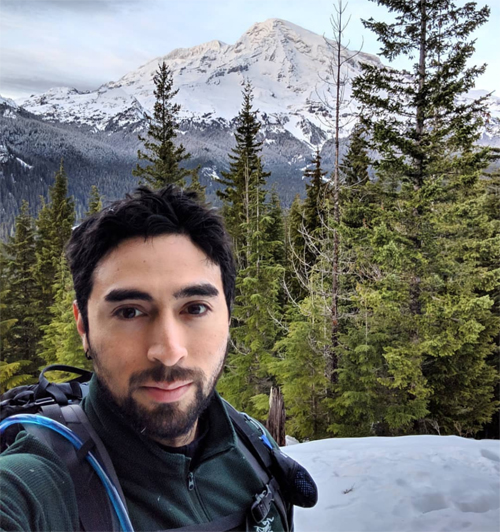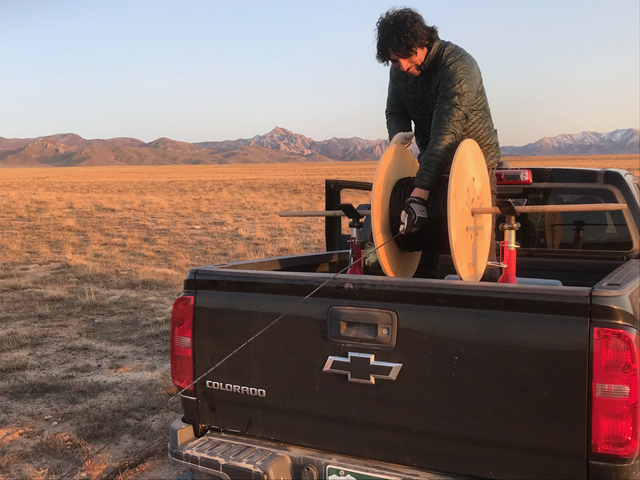29 June 2022–The scenes of devastation from the 2011 Tohoku earthquake and tsunami were part of what made Manuel Mendoza consider a career as a geophysicist, he says. The combination of interesting science, travel and the ability to help people were all factors that convinced him to study earthquakes.

Mendoza’s path to that decision was not a simple one. Growing up in Los Angeles with two younger siblings and a single mother, he was homeless during middle school and high school, traveling between shelters and hotels. “I had to learn how to navigate mostly on my own, as well as learn how to be a role model for my mother and my siblings to overcome what we were going through,” he said.
The family found a stable home by the end of high school, but by then Mendoza’s grades “were really poor,” he recalled. “Ds and Fs across the board, and the only B was in earth science my junior year.”
“I knew that I had potential. I knew that I wanted more, and that I wanted to do more,” he said. “So I just accepted my position. I knew that I wasn’t able to go directly into a university, like I had dreamed. Instead, I said, I’m going to take my time to explore potential career pathways, and I’m going to start rebuilding myself.”
As his mother battled cancer, Mendoza worked part time at McDonald’s and helped watch over his siblings while attending community college. Eventually his mother got her health back, his grades started going up, he received a scholarship that afforded him to focus full-time on classes, and eventually enrolled at the University of California, Riverside, where he finished his bachelor’s, master’s and Ph.D. degrees.
“The moment I realized I wanted to be a geophysicist and study earthquakes, I began seeing the Earth as my scientific playground,” he said. “I believe that my experiences in dealing with failure during my adolescence helped me perceive any challenge as an opportunity for growth and adventure. I think this perception was my biggest strength in graduate school.”
Today, Mendoza is a postdoctoral fellow at the Cooperative Institute for Research in Environmental Sciences (CIRES) at the University of Colorado, Boulder. He lined up a CIRES and NSF postdoctoral fellowship to work on two projects that use fiber optic Distributed Acoustic Sensing (DAS)–one at the Utah FORGE Geothermal facility and one at the Cascadia subduction zone in Washington State.

He is excited by the potential of DAS. During his dissertation research, for example, he used more traditional seismic instruments and methods to develop earthquake catalogs to delineate fault structures and understand seismotectonic processes in the Himalayas, “and I see now that with distributed acoustic sensing, we can tap into existing telecommunication fiber across the world, and convert them into large and dense seismic arrays to better resolve more information about the Earth than with traditional seismic instruments alone.”
“I kind of have this dream to bring something like DAS to other countries that are poorly instrumented, such as the Himalayas, for earthquake and tsunami early warning,” he said.
At FORGE, an underground field laboratory for studying breakthroughs in enhanced geothermal systems technology, Mendoza and others deployed about 1800 meters of optical fiber to acquire seismic data from hydraulic stimulation tests. While he analyzes those data, he is also working with telecommunication companies on a second project to tap into “dark” (unlit) fiber in Northwestern Washington to study seismicity and near-surface conditions in Cascadia to evaluate the seismic hazard.
“What I’m realizing is just how interdisciplinary DAS can be,” Mendoza said. “Already I’m talking to people from all over the place who aren’t necessarily studying earthquakes. It seems that a variety of problems and questions can be pursued simultaneously from, say, just a single DAS experiment. Naturally, this provides an excellent pathway to collaborate with various scientists and industry professionals across the country and around the world.”
Although these two projects are his first experiences with DAS, the seismic experiments he has participated in the past in the Himalayas and in California have given him “a sense of how the logistics of a project work out, how to think about the science, and the theoretical aspects of designing an experiment,” Mendoza explained. “That also gave me confidence and helped me be more bold when it came time for me to conduct my own experiments.”
These projects, along with a desire to teach the next generation of scientists, are making Mendoza lean toward a job in academia, he said. This summer he is mentoring an undergraduate student, and he does a lot of public outreach to K-12 schools—something he hopes to continue. “I’m especially attracted to schools that are probably not in the best communities, with students who don’t have that much exposure to science, and adequate resources and mentorship to pursue it,” he said. Mendoza is also a member of the Society of Latinxs/Hispanics in Earth and Space Science, a CIRES initiative and community, where he is helping to increase the number, visibility and success of underrepresented minorities in academia and beyond.
“Perhaps I take after my mother who has a very big heart, even for strangers,” Mendoza added. “I really hope that I can be a scientist that contributes to the mission of more inclusive science and just a healthier overall environment in academia, where people of various backgrounds and identities will be able to thrive towards whatever it is that makes them happy.”
SSA At Work is a monthly column that follows the careers of SSA members. For the full list of issues, head to our At Work page.
